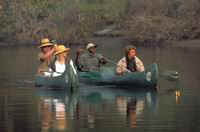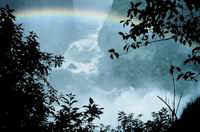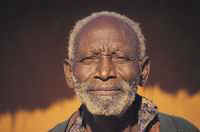| |
|
General
Information about Zambia
(Deutscher
Text) |
General Information on Zambia
Vast tracts of wilderness, sensational wildlife and few other tourists, are the hallmarks
of Zambia - called "The Real Africa".
Zambia is a landlocked country of 752 617 kmē, about twice the size of
California, just
covering 2,5 % of the African continent.
Zambia borders on Tanzania in the northeast, Malawi in the east, on Mosambique in the
southeast, Zimbabwe and Botswana in the south, Namibia in the
southwest, Angola and the
Democratic Republic of Congo in the west.
A great plateau of 1000 to 1500 metres above sea level, cleaved by two major valleys - the
Zambezi and Luangwa, dominates central Zambia.
With the many rivers and lakes Zambia has the biggest fresh water resources in southern
Africa. The Zambezi is the main river, after which the country was
named, and crosses the
country with 1 550 km. Other important rivers are the Kafue River in the central and the
Luangwa and Luapula in the east.
Bordering onto Zambia are the following big lakes: Lake Mweru (bordering onto the
Democratic Republic of Congo), Lake Tanganyika, which is shared with the Democratic
Republic of Congo, Burundi and Tanzania and Lake Kariba, a man made dam on the border with
Zimbabwe.
The biggest city is Lusaka, the capital, with 1,2 million inhabitants.
History:
Actual finds prove that humans lived in Zambia at least 250 000 years
ago.
In the 3rd century Bantu-speaking tribes immigrated to Zambia. They were mostly cattle
breeders and crop-farmers.
In the 14th century farming communities along the Zambezi River traded Muslims from the
East African coast.
Trading commodities included ivory, copper, gold and slaves in the 17th-19th
centuries.
In 1851 David Livingstone arrives in the Upper Zambezi. In 1855 he discovered the Victoria
Falls, which he renamed after Queen Victoria.
He died in 1873 from dysentery in the Bangweulu Wetlands.
In the early 1890 Cecil John Rhodes, who was already establishing mines and vast business
empires in South Africa, under the British South African Company (BSAC) laid claim on
Zambia. By 1891, Rhodes British South Africa Company had proclaimed the territories of
Southern Rhodesia and Northern Rhodesia.
1902 vast deposits of copper were discovered in the area now called the
Copperbelt.
In 1923 the colony was put under direct British control and in 1935 the capital was moved
from Livingstone to Lusaka.
In 1958 Kenneth Kaunda's Zambia African National Congress was banned and its leaders
imprisoned.
In 1960 Kaunda took control of anther party, the United National Independence Party
(UNIP).
In 1964 Zambia gained independence, with Kenneth Kaunda as the first
president.
Kaunda remained in power until 1990.
His rule was based upon "humanism" - his own mix of Marxism and traditional
African values.
1991 Frederik Chiluba of the Movement for Multiparty Democracy became president after full
presidential and parliamentary elections.
He was succeeded by Frederik Mwanawasa in 2001.
Population and People:
Zambia has a population if about 10 million people, which is roughly 13 people per square
kilometre - one of the lowest population ratios in Africa. Zambia has a population growth
rate of 2%.
About half of the population is concentrated on urban areas, like Lusaka and the cities in
the Copperbelt.
There are 73 officially recognised ethnic groups, (in order of size) with the
Bemba,
followed by the Tonga, the Nyanja, the Ngoni and the Lozi.
The official national language is English, but seven tribal languages are also
recognised: Bemba, Tonga, Nyanja, Lozi, Lunda, Kaonde and Luvale.
Many different dialects are also spoken.
The minority are the Europeans, Asians and Bushmen.
50 - 60% of the population are Christians, and the rest is follows the Hinduism or are
Muslim.
Traditional believes and religions are still practiced.
Climate:
Zambia's climate is tropical, with the main rainy season from October to April. In the
north of the country the average rainfall is about 1 400 mm, and in the south 750 mm. The
mostly comes with heavy thunderstorms.
Temperatures in the Zambezi and Luangwa Valley rise in summer to 40° C. The temperatures
in the highland are more moderate.
From May to August it is cool and dry. Light frost might occur in the lower
areas.
National Parks and Reserves:
Zambia boasts 19 national parks and reserves administered by the Zambia Wildlife
Authority.
Many parks are very remote and after many years of bad management, many are just lines on
the maps, offering no facilities at all.
However, four National Parks do accommodate healthy stocks of wildlife, and are among the
best in Southern Africa, offering camps and lodges.
Lochinvar National Park is located 250 km southwest of Lusaka and has an area of 428kmē
covering the flood plains of the Kafue Flats.
It boast over 30 000 Kafue lechwe as well as abundant bird life.
The Mosi-oa-Tunya National Park is located near Livingstone and has an area of 76 kmē,
including the eastern section of Victoria Falls, spectacular gorge scenery and a
well-stocked game area.
Lower Zambezi National Park is situated on the northern bank of the Zambezi River east of
Lusaka and has an area of 4092 kmē. Highlights include abundant
elephant, buffalo and hippo, all of which can be observed on land by
canoe.
South Luangwa National Park is located in the Luangwa Valley and has an area of 9050kmē.
It is one of Africa's finest reserves with abundant and varied wildlife that is best on a
walking safari.
Zambia's largest park is the Kafue National Park and has an area of 22 400kmē, including
the Busanga Plains. Diverse and abundant antelope and high predator numbers are found
here.
Other parks are the North Luangwa National Park, Kasanka National Park, Sumbu National
Park, Nyika Plateau National Park and Liuwa Plain National Park.
Economy:
Zambia's economy is dominated by agriculture and generates exports of
tobacco, vegetables, fruit, coffee, tea and ornamental flowers. Other domestic farming products include
maize, sorghum, rice, peanuts, sunflower seeds, cotton, sugar cane,
cassava, cattle, goats, pigs,
poultry and eggs. But the country still needs to import a lot of food and the economy is
largely dependent on international aid.
Zambia's main industry is mining, and it is the world's forth-largest supplier of copper
and the leading producer of cobalt. These two minerals generate 75% of the country's
foreign exchange.
Manufacturing industries mainly produce textiles and cement.
Infrastructure:
Zambia has a road network of about 66 000 km, but only about 6 500 km are
tarred. The
other roads quickly become impassable during the height of the summer
rains.
There are, however, more than a hundred airports and airfields scattered across the
country, some of them are international airports, offering relatively simple access to
even the remotes parts of the country.
Rail is limited to 2 200 km rail. This is partially owed by the Tanzania-Zambia Railway
(TAZARA).
Due to the many rivers and lakes transportation by ship, boat and ferry play an important
role.
Entry Requirement:
Generally, all visitors need a visa, except citizens of Commonwealth
countries. As the
immigration rules are complicated and change frequently we advise to check the latest
entry requirements before travelling. Visa exceptions are made for tourist travelling on
organised trips in conjunction with local operators. Check this with your travel
agent.
All visitors do require valid passports and return air tickets.
Health requirements:
Yellow fever certificates are only required if you enter Zambia from a yellow fever
country.
In Zambia malaria is wide spread and do we strongly recommend travellers to take the
necessary precautions.
Currency:
The Kwacha is Zambia's unit of currency. Most hotels, lodges, camps air charter companies
and safari operators accept US Dollar.
What to pack:
Take light, lose-fitting clothing. Earthy tones are important for walking safaris in order
to blend in with the surroundings. As it can get very cold at night in
winter, warmer
clothes are essential.
Other important items that you would need: hat, sunglasses, high-factor sunscreen
comfortable walking shoes, binoculars, camera and enough films, torch insect
repellent.
Most of the lodges and camps offer a same-day laundry.
Some books we would like to recommend:
- Bradt Travel Guide to Zambia - ISBN 1 898323 99 2
- The White Impala - by Norman Carr
- Kakuli: A Story about Wild Animals by Norman Carr - 1996 ISBN 0797-0415785
- The Africa House - by Christine Lamb - ISBN 0-670-87727-1
- Africa; A Biography of the Continent by John Reader - 1997 - ISBN
0-241-13047-6
A History of Zambia by Andrew Roberts - ISBN 0-8419-0291-7
Tales of Zambia by Dick Hobson - ISBN 0-952-7092-5-2
Travels and Researches in Southern Africa by David Livingstone 1857
Pole to Pole by Michael Palin 1999 ISBN 0563551062
A Field Guide to Zambian Birds not found in Southern Africa by Dylan
Aspinwall and Carl Beel ISBN 9982-811-00-1
African Wild Dog Survey in Zambia by Kenneth Buk
A Guide to Common Wild Mammals of Zambia 1991 ISBN 9982-05-000-1
A Guide to Reptiles, Amphibians and Fishes of Zambia - 1993 ISBN 9982-05-001-X
|








|
| Information about
the author: |
|
Heidi van Eck founded Sunbird Tours, a Namibian tour operator, in October 1997.
SUNBIRD TOURS is a small company specializing in individual and personalized tours for fly-in safaris, guided and self-drive tours.
Heidi van Eck, a born Namibian, has been working in the tourism industry since 1976. She has traveled the country extensively. With her well-experienced team of consultants we will craft your vacation into real and practical itineraries, enabling you to relax and enjoy your holiday.
We arrange tailor-made Fly-in Safaris, Individual Tours and Group Tours; book your accommodation, rented car, luxury train, day tours and visits to extraordinary destinations in Namibia, Botswana and Zambia.
The fly-in safaris are conducted in well-maintained aircraft and qualified commercial pilots.
Extensive tours or add-ons to Botswana and Zambia can be arranged.
For our guided groups we use air-conditioned busses, with knowledgeable guides. Tours for specialized groups, e.g. Birder's, fishing or incentive groups can be arranged.
Experience the vastness and beauty of the Namib Desert, the prolific game and bird life in the Etosha National Park and the unspoiled Okavango Delta.
Explore the relative unknown game parks of Zambia, for a real African experience and visit the awesome Victoria Falls.
We will introduce you to Namibia's cultural spectrum and the remarkable tradition of the Himba in the Kaokoland and the earliest known inhabitants of Namibia -
the Bushmen (San).
Cross the path of the "Big 5" in the African wilderness of Namibia, Botswana and Zambia.
Combine an unmatched contrast of the endless vastness of the Namib Desert and the profusion of wild life in the Okavango Delta.
Let us show you the essence of Africa, a treasure chest waiting to be
discovered,
with endless possibilities.
Take home memories that will last forever.
For more information please
visit our website
Sunbird
Tours Namibia |
| Weather
Forecast for Zambia: |
|

This Weather forecast is a service of
Wetter-Online.de
|
|